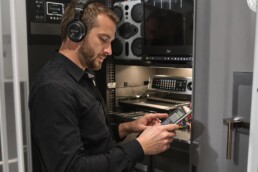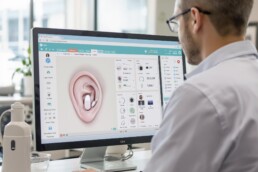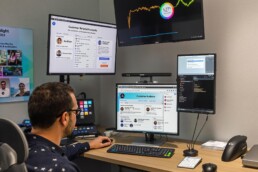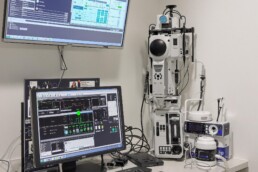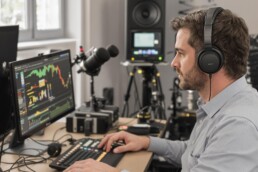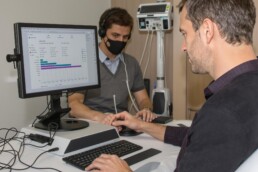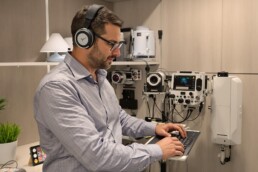Software for audioprosthetists: digital revolution in the service of auditory precision
The hearing aid industry is undergoing a profound transformation thanks to the rise of digital technologies. At the heart of this evolution, software for audiologists are much more than simple computer tools – they now form the central pillar of a revolutionary approach to managing hearing disorders. These sophisticated digital solutions radically change how professionals diagnose, treat, and monitor patients suffering from hearing loss.
The silent revolution of dedicated audiology software
The modern audiologist today has an impressive technological arsenal to optimize every step of the patient journey. Specialized software has significantly evolved, moving from simple databases to comprehensive digital ecosystems that orchestrate the entire hearing aid fitting process.
These platforms now incorporate advanced features such as:
- Precise analysis of audiograms with predictive modeling
- Real-time acoustic simulation to anticipate fitting outcomes
- 3D mapping of the ear canal for perfect adjustment
- Longitudinal tracking of hearing aids performance in various sound environments
As highlighted in our analysis on the digital revolution in audiology, these tools fundamentally transform hearing aid fitting by making it more precise and personalized.
Precise diagnosis: the era of augmented audiology
The assessment of hearing loss benefits greatly from software advancements. Sophisticated algorithms now analyze test results with unparalleled accuracy, allowing for detailed characterization of different types of deafness and their functional impacts.
Modern hearing aid software offers:
- Advanced spectral analysis of problematic frequencies
- Objective evaluation of speech intelligibility in noise
- Early detection of inner ear anomalies
- Correlation between objective data and subjective discomfort reported
This diagnostic precision forms the foundation for truly tailored auditory correction to meet each patient’s specific needs.
Extreme personalization: custom hearing solutions
The real revolution brought by these software lies in their ability to customize every aspect of the fitting. Hearing aid audiologists can now adjust parameters with millimeter precision based on individual acoustic characteristics, listening preferences, and frequently visited sound environments.
| Customizable parameters | Benefits for the patient |
|---|---|
| Adaptive frequency compression | Better perception of high consonants |
| Situational microphone directivity | Optimized understanding in noisy environments |
| Neuroadaptive noise reduction | Reduced auditory fatigue |
| Smart management of Tinnitus | Personalized relief from Tinnitus |
This hyper-personalization represents a paradigm shift in approaches to auditory disorders, as explained in our detailed article on the software for audiologists and their impact on transforming clinical practices.
Integrated management: beyond acoustics
Modern platforms go far beyond pure acoustics to offer comprehensive patient journey management. They now include:
- Complete administrative tracking (including reimbursements by health insurance and mutuals)
- Scheduling and trial periods management
- Secure storage of medical documents (including medical prescriptions from ENT doctors)
- Patient communication tools (reminder calls, usage advice)
This integrated approach allows hearing aid specialists to focus more on their clinical expertise while enhancing the overall patient experience.
Artificial intelligence: anticipating hearing needs
The gradual integration of artificial intelligence into hearing aid software opens fascinating prospects. These systems can now analyze usage habits of hearing devices, anticipate adjustment needs, and suggest settings modifications even before the patient experiences discomfort.
Predictive algorithms also optimize adaptation to hearing aids by proposing personalized learning curves that consider factors such as age, degree of hearing loss, presence of Tinnitus, or presbycusis.
Towards connected and collaborative audiology
The future of software for audiologists clearly points towards connected ecosystems where data flows seamlessly and securely between different stakeholders in the auditory pathway:
- Information sharing between audiologists and ENT doctors
- Remote hearing aid adjustments
- Integration of data from mobile applications used by patients
- Collective anonymized analysis to improve fitting protocols
This collaborative approach not only enhances care efficiency but also helps reduce obstacles related to mobility or geographical distance, making auditory services more accessible.
Today’s software for audiologists are much more than mere technical tools – they embody a new philosophy of care where precision, personalization, and continuity are at the service of better auditory quality of life. For hearing-impaired individuals, this digital revolution translates into more effective, comfortable solutions that are perfectly adapted to their specific lifestyles.
